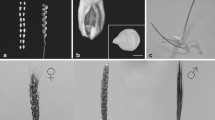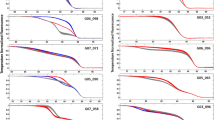Summary
We have determined that meiotic recombination differs between male and female gametes derived from the same plant. A single F1 plant was backcrossed to each of the parents, Lycopersicon esculentum and L pennellii, as the male (BCE) and female (BCP) parent, respectively. A total of 85 RFLP markers, covering more than 75% of the tomato genome, was used to construct a genetic map for both populations. Since both recurrent parents were homozygous, recombination measured in each population reflects crossing-over rates leading to male (BCE) and female (BCP) gametes. Comparisons were made by interval (genetic distance between two adjacent markers), by chromosome, and for the total length of the genome. Significantly less recombination was observed for male gametes at all levels. No significant relationship was found between areas of reduced recombination and approximate location to the centromere. That selection plays some role could not be eliminated, but no clear evidence was observed for single-locus selection as a major factor in the general reduction of crossing-overs in male gametes.
Similar content being viewed by others
References
Andersson L, Sandberg K (1984) Genetic linkage in the horse. II. Distribution of male recombination estimates and the influence of age, breed and sex of recombination frequency. Genetics 106:109–122
Baker BS, Carpenter ATC, Esposito MS, Esposito RE, Sandler L (1976) The genetic control of meiosis. Annu Rev Genet 10:53–134
Beatty RA (1975) Genetics of animal spermatozoa In: Mulcahy DL (ed) Gamete competition in plants and animals. North Holland, Amsterdam, pp 61–68
Bernatzky R, Tanksley SD (1986a) Majority of random cDNA clones correspond to single loci in the tomato genome. Mol Gen Genet 203:8–14
Bernatzky R, Tanksley SD (1986b) Toward a saturated linkage map in tomato based on isozymes and random cDNA sequences. Genetics 112:887–898
Carlson WR (1988) The cytogenetics of corn. In: Sprague GF (ed) Corn and corn improvement. American Society of Agronomy, Madison Wi, pp 286–288
Darlington CD (1934) Anomalous chromosome pairing in the male of Drosophila pseudo-obscura. Genetics 19:95–118
Donis-Keller H, Green P, Helms C, Cartinhour S, Weiffenbach B, Stephens K, Keith TP, Bowden DW, Smith DR, Lander ES, Botstein D, Akots G, Rediker KS, Gravius T, Brown VA, Rising MB, Parker C, Power JA, Watt DE, Kauffman ER, Bricker A, Phipps P, Muller-Kahle H, Fulton TR, Siu Ng, Schumm JW, Braman JC, Knowlton RG, Baker DF, Crooks SM, Lincoln SE, Daly MJ, Abrahamson J (1987) A genetic linkage map of the human genome. Cell 51:319–337
Feinberg AP, Vogelstein B (1983) A technique for radiolabeling DNA restriction fragments to a high specific activity. Anal Biochem 132:6–13
Gadish I, Zamir D (1986) Differential zygotic abortion in an interspecific Lycopersicon cross. Genome 29:156–159
Graf JD (1989) Genetic mapping in Xenopus laevis: eight linkage groups established. Genetics 123:389–398
Hardon JJ (1967) Unilateral incompatibility between Solanum pennellii and Lycopersicon esculentum. Genetics 57:795–808
Heslop-Harrison J (1975) Male gametophyte selection and the pollen-stigma interaction. In: Mulcahy DL (ed) Gamete competition in plants and animals. North Holland, Amsterdam, pp 177–190
Johnson KR, Wright JE, May B (1987) Linkage relationships reflecting ancestral tetraploidy in salmonid fish. Genetics 116:579–591
Lander ES, Green P, Abrahamson J, Barlow A, Daly MJ, Lincoln SE, Newburg L (1987) MAPMAKER: an interactive computer package for constructing primary genetic linkage maps of experimental and natural populations. Genomics 1:174–181
Maeda T (1939) Chiasma studies in the silk worm, Bombyx mori L. Japanese J. Genet. 15:118–127
Morgan TH (1912) Complete linkage in the second chromosome of the male Drosophila. Science 36:719–720
Murphy TM, Thompson WF (1988) Molecular plant development. Prentice Hall, New York
Rick CM (1969) Controlled introgression of chromosome of Solanum pennellii into Lycopersicon esculentum: segregation and recombination. Genetics 62:753–768
Rick CM (1972) Further studies on segregation and recombination in backcross derivatives of a tomato species hybrid. Biol Zentralbl 91:209–220
Robertson DS (1984) Different frequency in the recovery of crossover products from male and female gametes of plants hypoploid for B-A translocations in maize. Genetics 107:117–134
Stadler LJ (1926) The variability of crossing-over in maize. Genetics 11:1–37
Stephens SG (1949) The cytogenetics of speciation in Gossipium I. Selective elimination of the donor parent genotype in interspecific backcrosses. Genetics 34:627–637
Tanksley SD (1983) Introgression of genes from wild species. In: Tanksley SD, Orton TJ (eds) Isozymes in plant genetics and breeding. Elsevier, Amsterdam, pp 331–338
White R, Leppert M, O'Connell P, Nakamura Y, Julier C, Woodward S, Silva A, Wolff R, Lathrop M, Lalouel JM (1986) Construction of human genetic linkage maps. I. Progress and perspectives. Cold Spring Harbor Symp Quant Biol 51:29–38
Young ND, Tanksley SD (1989) RFLP analysis of the size of chromosomal segments retained around the Tm-2 locus of tomato during backcross breeding. Theor Appl Genet 77:353–359
Zeven AC, Knott DR, Johnson R (1983) Investigation of linkage drag in near isogenic lines of wheat by testing for seedling reaction to races of stem rust, leaf rust and yellow rust. Euphytica 32:319–327
Zhuchenko AA, Korol AB, Vizir IYu, Bocharnikova NI, Zamorzaeva IA (1989) Sex differences in crossover frequency for tomato and thale cress (Arabidopsis thaliana). Sov Genet 24:1104–1110
Author information
Authors and Affiliations
Additional information
Communicated by G. Wenzel
Rights and permissions
About this article
Cite this article
de Vicente, M.C., Tanksley, S.D. Genome-wide reduction in recombination of backcross progeny derived from male versus female gametes in an interspecific cross of tomato. Theoret. Appl. Genetics 83, 173–178 (1991). https://doi.org/10.1007/BF00226248
Received:
Accepted:
Issue Date:
DOI: https://doi.org/10.1007/BF00226248




